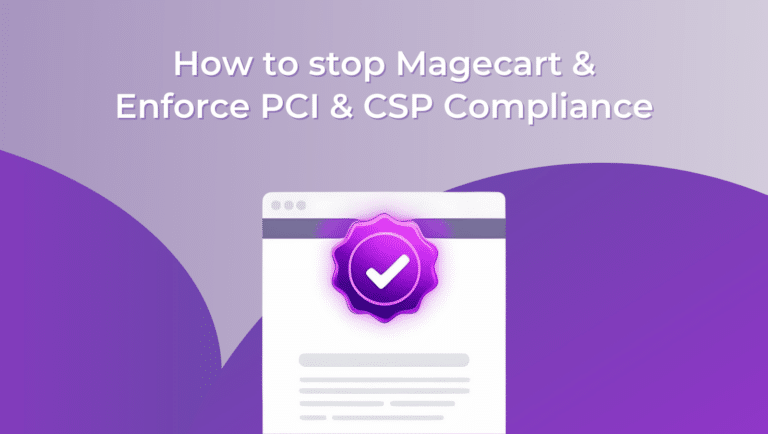To properly protect web applications and web pages from client-side attacks, cybersecurity professionals and web application developers have a few approaches available to them. If you’ve been following the Feroot blog, you will have learned about the first six client-side security approaches. They all have benefits and limitations. Feel free to revisit the blogs below to learn more.
- Web Application Firewalls
- Content Security Policy
- Penetration Testing, Vulnerability Assessments, and Security Assessments
- Vulnerability Scanning
- JavaScript Security Permissions
- Code Obfuscation & Scrambling
Before you do go, take some time to read a little more about the final client-side security approach:
- Client-side Attack Surface Monitoring
In this latest blog on the topic of protecting web applications and web pages from client-side attacks, we’ll walk through what client-side attack surface monitoring solutions do and why they are valuable to detecting and defending from Magecart, cross-site scripting, formjacking, and other front-end attacks.
What are client-side attack surface monitoring solutions?
Client-side attack surface monitoring solutions are a relatively new cybersecurity technology that automatically discovers all of a company’s web assets and reports on their data access. These solutions use headless browsers to navigate through all the JavaScript contained on the website and web application pages. They gather realtime information about how the scanned website works from the end-users perspective.
A key component of the technology is synthetic users, which are deployed during threat detection scans to act and interact the way a real human would when completing websites and web application tasks. These synthetic users can complete a variety of activities, such as:
- Clicking active links
- Watching embedded videos
- Waiting for pages to load
- Navigating between pages
- Clicking on, opening, and closing pop-up messages
- Scrolling through pages
- Submitting forms
- Solving Captchas
- Entering financial information
Each synthetic user interaction with the web application is logged and monitored. These solutions then engage in behavioral analyses and inject logic into each page to gather information that is difficult to collect manually, including:
- The type of data collected by forms.
- The type of data third-party scripts have access to.
- Any first- and third-party scripts that are fingerprinting users and their browsers.
- The types of trackers that are deployed on the page and their activities.
- The existence of any forms or third-party scripts transferring data across national boundaries.
- Any first- and third-party scripts which are being loaded directly into the user’s browser, and/or are being sideloaded or chainloaded into the user’s browser.
- The presence of any malicious hosts exfiltrating data.
Evaluation of web applications from a security perspective isn’t the only thing that client-side attack surface monitoring solutions do. They also perform post-scan informational analyses to offer businesses synthesized intelligence to secure web applications from harm.
In addition, they analyze all information synthetic users collect and enumerate client-side threat intelligence for security teams to act on quickly and effectively. Built-in machine learning capabilities also identify and classify data to detect and report on a variety of client-side security challenges. The type of intelligence available includes:
- Active malware
- Live marketing or other tracking software
- Geographic IP information
- Obfuscated scripts
- Data assets collected (financial, PII, etc.)
- Historical overview of your client-side attack surface
- Client-side security trends
- Types of webpages (login, billing, etc.)
- SSL issues
- Known JavaScript vulnerabilities
What limitations do I need to be aware of?
The limitations are minimal for this client-side security approach. Client-side attack surface monitoring solutions are easy to set up and maintain on existing web applications, and can discover more client-side cyber threats than any of the approaches discussed in this blog series. These cyber defense technologies do require interaction between cybersecurity and application development teams. To properly secure businesses from client-side threats, teams need to understand the ins and outs of client-side application structures. With strong collaboration between security and application development teams, businesses can secure their client-side web applications with ease.
Are client-side attack surface monitoring solutions right for me?
If your business interacts with customers via web applications or web pages, then yes, client-side attack surface monitoring solutions will enable your business to stay ahead of client-side cyber threats. Client-side attack surface monitoring solutions condense manual processes traditionally undertaken by security analysts and web application developers from days to minutes. With automated alerts and detailed issue enumeration, these technologies can enable security teams to automate client-side security tasks beyond any scope available with other client-side security approaches.
In closing
To truly defend your web application and websites you need to be fully aware of what assets, trackers, and scripts you are actively using. Moreover, you need to be 100% certain of what those assets are doing and how they are interacting with your users. Without a detailed inventory of your JavaScript web applications, threat actors can sneak in all sorts of malicious code to exfiltrate data or even deface your brand. If you would like to see a full fledged client-side attack surface monitoring solution in action, check out Feroot Inspector and register for a demo here: link.


